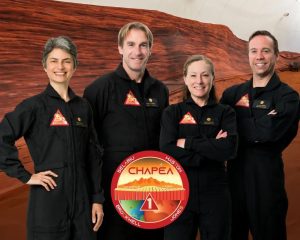Volunteers locked inside a Mars simulator for 378 days are now free

 The crew of NASA’s first Mars habitat simulation, CHAPEA 1, exited their Earth-based environment after 378 days on July 6 at 5 p.m. EDT.
The crew of NASA’s first Mars habitat simulation, CHAPEA 1, exited their Earth-based environment after 378 days on July 6 at 5 p.m. EDT.
Greeted by friends, family, mission team members and project directors, the crew of four expressed gratitude and optimism about their time in isolation and the data collected, which will contribute to the future goal of putting boots on Mars.
The egress event at the Johnson Space Center was initiated by Deputy Director Steve Koerner, who expressed sincere gratitude to the team and their families and highlighted the crucial data gathered over the course of the project.
The four crew members included Mission Commander Kelly Haston, Flight Engineer Ross Brockwell, Medical Officer Nathan Jones, and Science Officer Anca Selariu. NASA astronaut and Deputy Director of Flight Operations Kjell Lindgren ceremonially opened the habitat door, officially bringing the team out of isolation.
Koerner remarked on the mission’s significance: “Mars is our goal. As global interests and capabilities in space continue to expand, America is poised to lead.” The mission, primarily focused on nutrition-based science but included cross-disciplinary experiments that simulated various aspects of life on Mars.
“They’ve been separated from their families, placed on a carefully prescribed meal plan, and undergone a lot of observation. By growing and harvesting their own vegetables, dealing with communication delays and conducting simulated Mars walks, this team has helped us obtain crucial information as we prepare to return to the moon and on to Mars,” Koerner added.
Principal Investigator Grace Douglas reiterated her thanks on behalf of NASA to the team and their families for their incredible sacrifice.

“This project has enabled the collection of thousands of data points, yielding a unique and valuable integrated dataset in a Mars-realistic simulation. These data will provide unprecedented insight into how engineers, scientists, and astronauts can work together to achieve mission objectives while maintaining health and performance for the success of future human missions to Mars.”
Douglas also thanked the science, engineering, and mission control teams who worked tirelessly to support the crew and ensure data integrity for mission success. The development of this analogue mission was a unique challenge for the engineering teams.
Director of Engineering Julie Kramer White noted, “From working with the teams to outfit the habitat, whether it was Mars walks, robotic operations, or habitat maintenance—planned and unplanned—the analogues are crucial in understanding what it’s going to take and if our architectures will work when plans meet reality.”
One of the key reasons for conducting missions like CHAPEA 1 is their ability to gather critical data in a controlled, safe environment.
By simulating Mars-like conditions on Earth, researchers can test the limits of human endurance, develop effective countermeasures for potential health risks, and fine-tune the technological systems necessary for long-term space missions.
This controlled setting allows for rigorous experimentation and monitoring without the immediate dangers posed by actual space travel. The information obtained from these simulations is invaluable; it helps identify potential issues and solutions before committing resources to more dangerous and expensive missions beyond Earth’s atmosphere.
This approach not only enhances the safety and well-being of future astronauts but also ensures that every step taken towards Mars is based on robust scientific evidence and meticulous planning.
As Douglas pointed out, the data collected from CHAPEA 1 will provide unprecedented insights into maintaining health and performance, which are crucial for the success of future human missions to Mars. By testing scenarios and gathering data on Earth, NASA can mitigate risks, improve mission outcomes, and ultimately, make human exploration of Mars a safer and more achievable goal.
Mission Commander Kelly Haston expressed pride and gratitude for the experience, noting the support from her crew, friends, family, and partner. Flight Engineer Ross Brockwell highlighted the importance of sustainable living principles learned during the mission. Medical Officer Nathan Jones shared his appreciation for the opportunity and the crew’s camaraderie and Science Officer Anca Selariu emphasized the mission’s role in uniting and inspiring humanity.
NASA also conducts isolation research across multiple projects, such as the Human Exploration Research Analog, expeditions to Antarctica, and other simulation environments, in addition to human spaceflight missions aboard the International Space Station.
These efforts aim to achieve specific and essential research objectives that will guide future human expeditions to the Moon and Mars.
The CHAPEA simulated missions stand out because they examine the effects of prolonged isolation and confinement, incorporating Mars-like communication delays with Earth – up to 44 minutes roundtrip – and resource constraints pertinent to Mars, including a more restricted food system compared to what can be supported on the space station and in other simulation environments.
The completion of CHAPEA 1 is a significant milestone as NASA prepares for future Mars missions. Stay tuned for CHAPEA Mission 2 next year and CHAPEA Mission 3 in 2027, as the journey to Mars continues.
Source: www.universetoday.com




